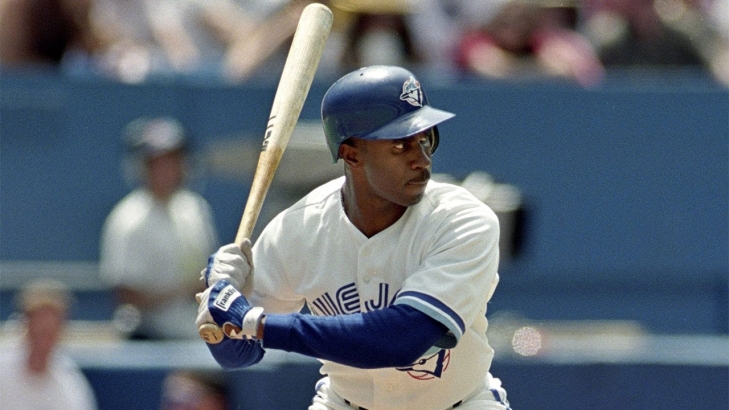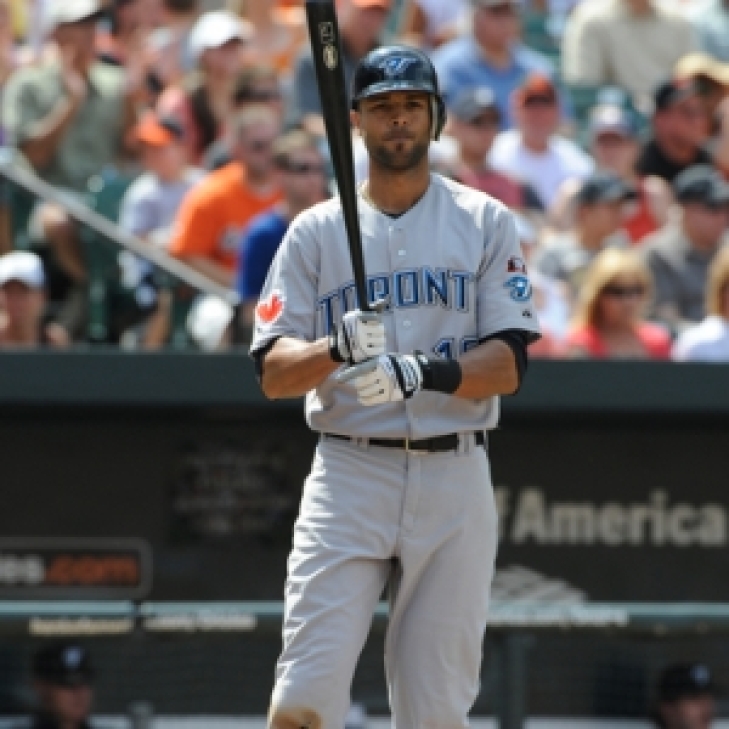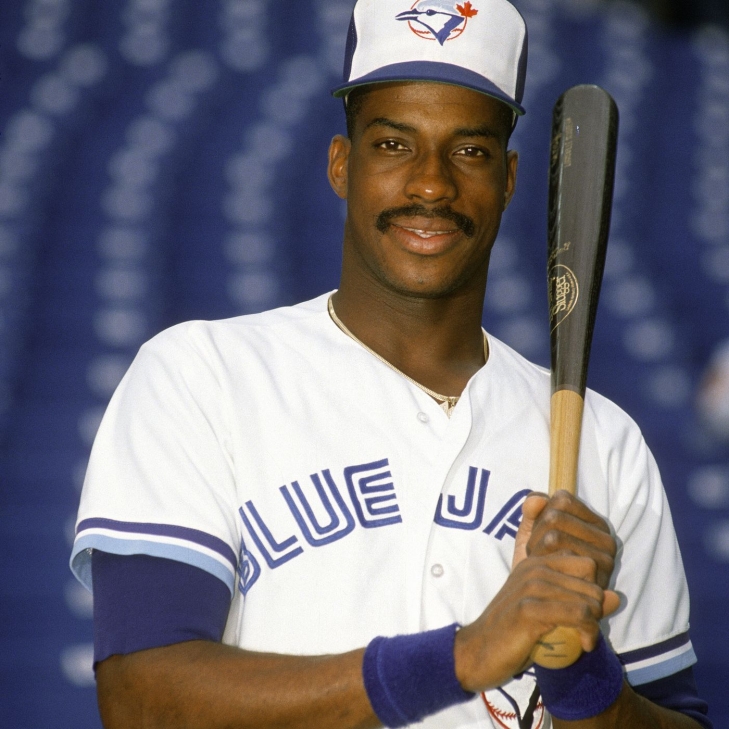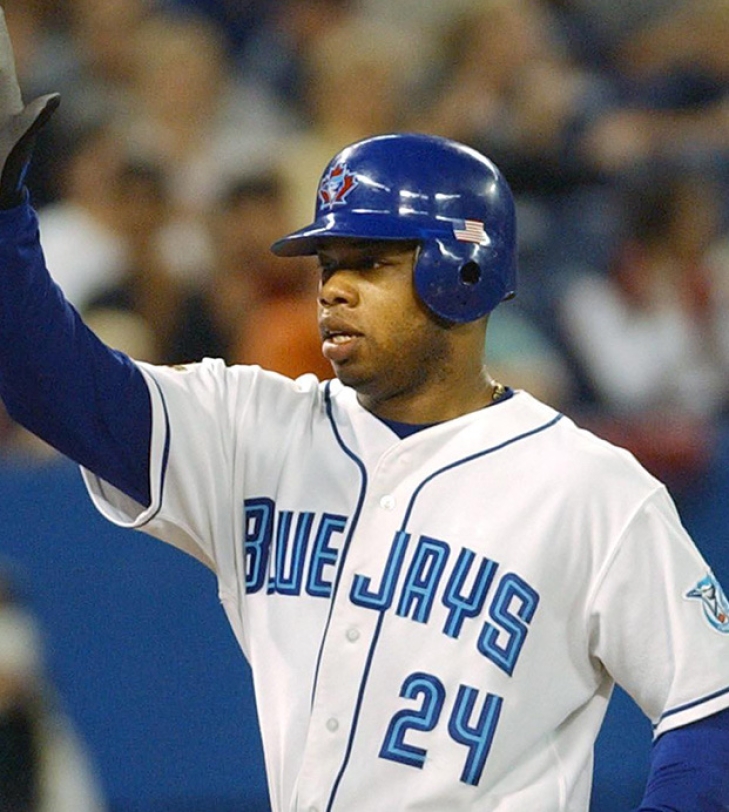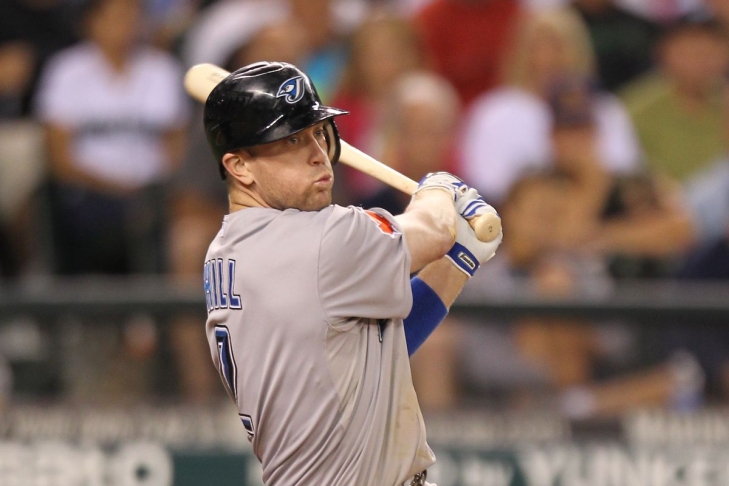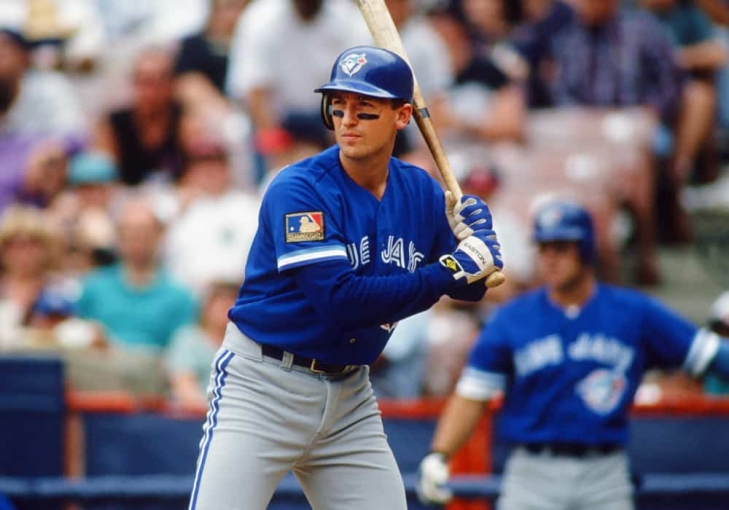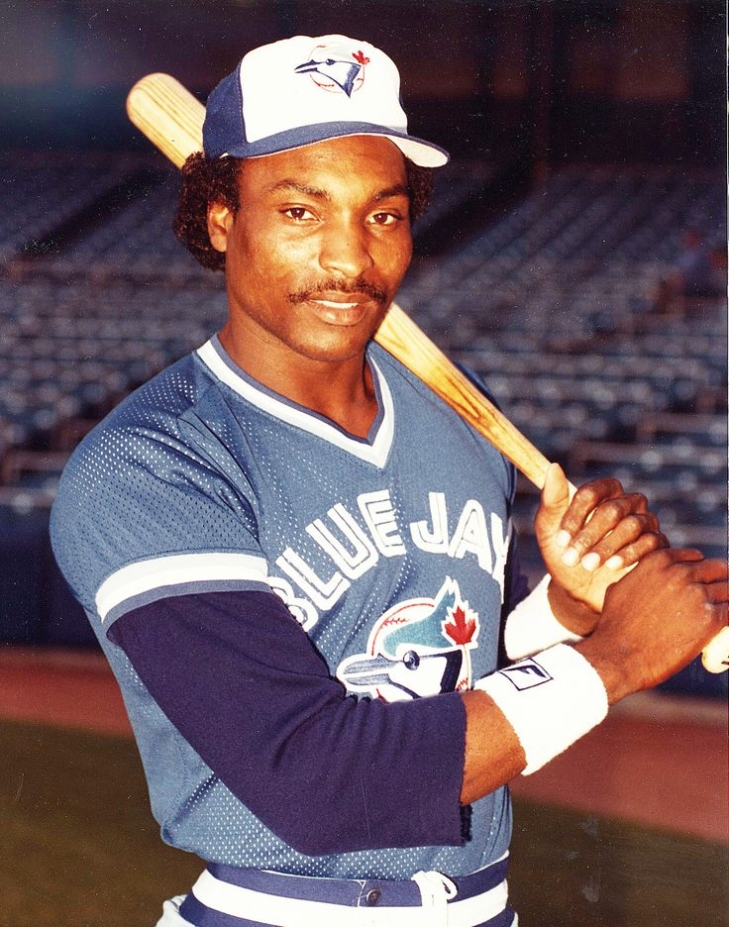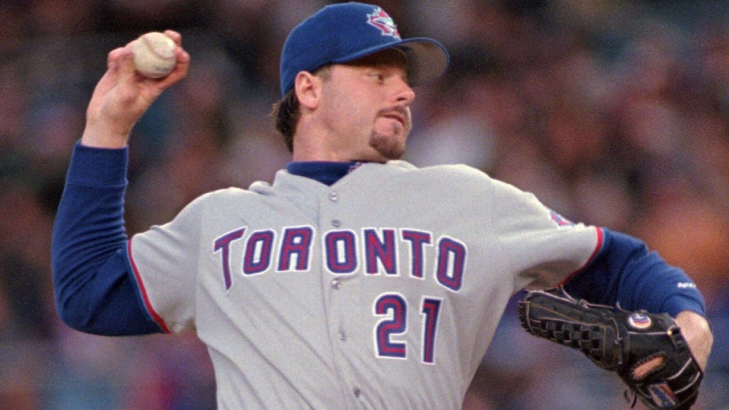20. Devon White
In the glory days of the early 90s Blue Jays, Devon White was their leadoff man, helping them win their coveted back-to-back World Series Titles in 1992 and 1993.
White first tasted Major League action in 1985 as a member of the California Angels and was a starting Centerfielder two years later. White made his first All-Star Game in 1989, but after a sub-par 1990, White was traded to Toronto in a transaction that history favored the Blue Jays.
White’s first three years in Toronto were fantastic. A Gold Glove recipient in all five of his Jays years, White led the AL in Total Zone Runs in 1992 and Defensive bWAR and was a crucial cog in the Jays World Series wins in 1992 and 1993, the latter of which was an All-Star year. In all those campaigns, White had at least 155 Hits, 15 Home Runs, and 30 Stolen Bases, but as competent as he was with his bat, he was considered the best defensive Centerfielder in the American League.
White slipped in 1994 and 1995, though he was still good, he left for the Marlins for the 1996 Season via free agency. With Toronto, White batted .270 with 733 Hits and 126 Stolen Bases.
27. Bo Bichette
The son of former Colorado Rockies' star Dante Bichette, Bo Bichette was a star at Arizona State, which he parlayed into a Second Round Pick by the Toronto Blue Jays in 2016. Three years later, the second-generation player was called up, and he has taken over where his father left off. Bichette played only in 46 Games that year for the Jays but batted .311 with 11 Home Runs and matched Ted Williams' rookie mark of nine straight games with an Extra Base Hit.
Bichette missed a lot of the COVID-shortened 2020 but exploded in 2021, going to the All-Star Game with a league-leading 191 Hits while batting .298 with 298 with 29 Home Runs, 102 RBIs, and 25 Stolen Bases. He was now a star, a more balanced player than his dad, and was 12th in MVP voting. Bichette led the AL in Hits again in 2022 (189), was 11th in MVP voting, and had a good power year (24 HR). Last season, Bichette emerged as the Blue Jays best player, adding a second All-Star, and batting over .300 for the first time (.307).
Going into 2024, Bichette had the makings of an MVP, but he had his worst year to date, fighting injuries while finishing with a negative bWAR (-0.3) and .598 OPS. It has to be better for Bichette in 2025, for the Blue Jays to have any success.
36. Willie Upshaw
Willie Upshaw was taken from the Yankees organization via the Rule 5 Draft, with the Blue Jays hopeful that he would be the First Baseman of the future, and by 1982, four years after, he was their starter.
Upshaw was one of Toronto’s building blocks, and he had three straight 150 Hit years, the first two where he belted over 20 Home Runs. His best season was in 1983, where he had career-bests in HR (27), Hits (177), RBI (104), and the Slash Line (.306/.373/.515) and received votes for the MVP, finishing 11th. Upshaw could not reproduce that year but was a large part in getting them to their first playoff in 1985. He played three more years in Toronto before Cleveland bought his contract.
Upshaw’s offensive numbers look like he should be higher, but First Baseman generally are better producers, which hampers his rank a little.
35. Paul Quantrill
One of the few Canadians to play for a Canadian team, Paul Quantrill's hometown was London, Ontario, two hours away from Toronto. The Pitcher played collegiately at the University of Wisconsin and then professionally for the Red Sox and Phillies before the latter traded him to Toronto after the 1995 Season.
Quantrill's first year with the Blue Jays was dismal, going 5-14 with a 5.43 ERA and going back and forth as a starter and reliever. Going into 1997, Quantrill was assigned to the bullpen, and it was a good fit for him, as he kept his ERA low (1.94 in 1997 and 2.59 in 1998), and in 2001, he was an All-Star Middle Reliver, leading the AL in Games Pitched (80) with an 11-2 record.
Quantrill was traded to Los Angeles after his 2001 All-Star year, leaving the Jays with 386 appearances. He is also a part of the Canadian Baseball Hall of Fame.
24. Ernie Whitt
Ernie Whitt was in the Red Sox organization when the Toronto Blue Jays were formed, and they used one of their Expansion picks to take the Catcher, who would appear in 23 games for the parent club that year.
Whitt's ascension was slow, playing only 2 Games for the Jays in 1978 and zero in 1979, but the decade of the 1980s was Whitt's time to shine behind the plate. After becoming the primary Catcher in 1980, Whitt often was in a platoon situation as a Jay against right-handed Pitchers, which granted him the heavier load.
A favorite of Blue Jays' ace Dave Stieb, he had the opportunity to catch him in his lone All-Star appearance in 1985. That was the season when Whitt and Jays made their first post-season appearance. Whitt also collected over 100 Hits for the first time and would accomplish that in the next five years while also having a nine-year run of 10-plus Home Runs.
Whitt was traded to make room for younger Catchers, and when it was all said and done, the popular player managed 888 Hits with 131 Home Runs. He is also a member of the Canadian Baseball Hall of Fame.
37. Kevin Pillar
Kevin Pillar was the best player at California State University, where he set a Division II school hit streak record with 54 Games. As good as he was, Pillar still played in Division II and dropped to the 32nd Round of the 2011 Draft, but Pillar defied the odds and first made the Blue Jays in only two years.
Pillar entered the 2015 season as Toronto's starting Centerfielder, and he batted .278 with 163 Hits and a Wilson Platinum Glove. The Blue Jays were contenders, with Pillar providing the occasional clutch hit. Toronto reached the ALCS in 2015 and did so again in 2016, with a 144 Hit/.266 campaign.
He never played another playoff game in Toronto but had two more respectable years, though his OBP was not great. The Jays shipped him off to San Francisco early in the 2019 season, leaving Pillar with 641 Hits as a Blue Jay.
30. Kelly Gruber
Plucked from the Cleveland Indians in the 1983 Rule 5 Draft, Third Baseman Kelly Gruber would work his way up the ranks to become a starter in 1987.
Beloved by the women of Toronto, Gruber had his breakout in 1988, with his first 150-Hit year, with 16 Home Runs and a .278 Batting Average. He slightly improved his stats in 1989 (18 HR,.290) and was named to the AL All-Star Team. This bled into Gruber's best year, where he had career-highs in Home Runs (31), RBIs (118), and OPS (.842), and was named a Silver Slugger and Gold Glove winner, as well as adding a second All-Star. Gruber was fourth in MVP voting, and it appeared that he would get even better, but that was not the case.
Gruber began to deal with injuries afterward and was unable to build on his best year. He was still the starting Third Baseman on Toronto's 1992 World Series Championship Team, but that would be his swansong as a Blue Jay, with the club trading him to the Angels after the season.
Gruber had an even 800 Hits with the Jays, 114 as Home Runs.
26. Alex Rios
A First Round pick in 1999, Alex Rios debuted with the Blue Jays in 2004 as their starting Rightfielder. Rios was fifth in Rookie of the Year voting (122 Hits, .286 BA) but did not show any power, with only one Home Run. He improved in that aspect, peaking with 24 Home Runs and 85 RBI, his second of two All-Star years.
Rios also developed into a solid hitter, batting over .290 three years straight (2006-08), with an added speed game, swiping a career-high 32 bases in 2008. He looked like a potential superstar, but 2009 was an implosion for Rios.
Rios's numbers plummeted, including a five-strikeout game. The fans turned on Rios, and he, in turn, hated them back. Toronto placed Rios on waivers, and though he won a World Series Ring in his final year in the Majors (2015 with Kansas City), his All-Star days were behind him.
Rios contributed 875 Hits, 81 Home Runs, 112 Stolen Bases, and a .285 Batting Average as a Blue Jay.
23. Fred McGriff
The Cooperstown career of Fred McGriff began in Toronto (well, in the Yankees organization, before they traded him as a Minor Leaguer in 1986, appearing in three Games, but the First Baseman appeared in 107 Games the year after, blasting 20 Home Runs, and proving himself as a capable Major League power hitter.
Entering 1988, “The Crime Dog” was now one of the better First Basemen in the AL, and he broke out with a 34 Home Run/82 RBI season. 1989 was his best year in a Blue Jays uniform, winning the Home Run (36) and OPS Title (.924) with a Silver Slugger and All-Star Game appearance. McGriff was also sixth in MVP voting.
After another good year in 1990, McGriff was traded to San Diego, leaving behind 130 Home Runs. The Jays would win the 1992 and 1993 World Series, but McGriff got his rig shortly after in 1995 as an Atlanta Brave.
In 2023, McGriff was chosen by the Veteran’s Committee for the Baseball Hall of Fame.
25. Shannon Stewart
Shannon Stewart's MLB career began with the Blue Jays in 1995, after their back-to-back titles, but still, an era where the SkyDome was rocking.
Stewart worked his way to starting at Center in 1998, swiping 51 bases with a .279 Batting Average. His basepath acumen dipped afterward, but Stewart batted over .300 for the rest of his four-and-a-half years in Toronto and showed good power with six straight 10-Home Run years.
The Blue Jays were no longer a contender in the early 2000s, and Stewart was traded to Minnesota for their playoff run. Stewart collected 1,082 Hits, and batted .298 with 74 Home Runs with 166 Stolen Bases for Toronto.
31. Aaron Hill
The Toronto Blue Jays used their 2003 First Round (13th Overall) to take LSU star Aaron Hill, who only needed two years to work his way through the Minors to make the parent club.
Hill played 104 Games in the infield as a rookie but only sat out seven Games over the next two seasons (2006 & 2007), batting .291 in both years. Showing skill offensively and defensively, Hill was injured for most of 2008 but had his most remarkable year in 2009. This was the year where he had career-highs in Home Runs (36), RBIs (108), and OPS (.829), and he was an All-Star and Silver Slugger. Hill also was 12th in MVP voting and won the AL Comeback Player of the Year.
2010 was inconsistent for Hill, who batted only .205 but belted 26 Home Runs. The Blue Jays, who declined his option the year before, traded the Infielder to the Diamondbacks during the 2011 Season, ending Hill’s stint in Toronto with 881 Hits and 96 Home Runs.
29. Duane Ward
Duane Ward only played only 10 Games for the Braves in the 1986 season before he was traded to the Blue Jays straight up for Doyle Alexander. Ward was in the Minors for most of the rest of 1986 and 1987, but by 1988, he was a dependable middle-innings reliever, eventually settling into an eighth-inning role to set up Tom Henke.
Henke departed for Texas as a free agent, and Ward took over as the closer, going to his first All-Star Game, leading the league in Saves (45), and helping Toronto repeat as World Series Champions. Ward still had plenty of Save opportunities, and he closed 76 Games from 1988 to 1992, leading the AL in Games Pitched (81) in 1991 and helping Toronto win the World Series. He was also fifth in Cy Young voting.
Ward did not know it then, but that would be his end. He missed the entire 2014 Season due to biceps tendinitis, and he only played in four ineffective Games in 1995. Ward retired soon after, and he recorded 121 Sves for Toronto. The Canadian Baseball Hall of Fame also added Ward to their ranks.
28. David Wells
David Wells was not the best Pitcher in most of the staffs he appeared on, but the man known as "Boomer" was often the most known.
The Blue Jays released Wells in 1993 before the season started, but he gradually got better and became one of Baseball's most potent lefthanded starters. Wells began his career with the Blue Jays, with the first strictly in the bullpen. The southpaw split his next three years as a starter and reliever and won a World Series Ring with Toronto but saw limited action in the playoffs.
Roger Clemens wanted to play for a contender, and Wells, who was in New York, was traded to the Jays as part of the deal. In his second run with Toronto, Wells won 37 Games in two seasons, including 20 that led the AL in 2000. That year, Wells was an All-Star and was third in Cy Young voting, despite a 4.11 ERA, but it was a hitter’s era.
The still-struggling Jays traded Wells to the White Sox after 2000, and with the Blue Jays, he went 84-55 with 784 Strikeouts.
16. John Olerud
A Third Round Pick from Washington State, John Olerud is one of a handful of players who never played in the Minors before tasting the Majors.
Playing only a handful of games in 1989, the First Baseman was used in a platoon in 1990 and 1991, but it was evident that Olerud was ready to take it over full-time. Olerud was their everyday First Baseman when they won their first World Series in 1992, and he was one of the best players in the AL the following season when the Blue Jays repeated as champions.
Olerud was still good over the next three seasons, though he was not as offensively potent. Olerud won the 1993 Batting Title (.363) and led the league in OBP (.473), OPS (1.072), OPS+ (186), and Doubles (54). He finished third in MVP voting, and this was his only season as a Jay where he went to an All-Star Game. Toronto traded Olerud to the Mets as part of an overhaul, leaving the organization with 910 Hits, 109 Home Runs, and a Batting Average of .293. Olerud was also inducted into the Canadian Baseball Hall of Fame.
17. Josh Donaldson
The Oakland Athletics had a budding star in Josh Donaldson, a Third Baseman, who was an All-Star in 2014 and finished in the top ten in MVP voting the past two years. Knowing that Donaldson would soon command a higher price, the Athletics traded him for multiple players, resulting in one of the best deals in Toronto history.
The Blue Jays felt they were on the cusp of a special team and went all in with the Donaldson trade. He rewarded their faith with an MVP season, where he smacked 41 Home Runs, led the American League in Runs (122) and RBIs (123), and secured his first Silver Slugger. Toronto made it to the ALCS, a lot of which was due to Donaldson.
Donaldson was again the anchor in 2016 for Toronto’s return to the ALCS, where he went to his third straight All-Star Game with a 37 Home Run/99 RBI year and a fourth-place MVP finish. After another good year in 2017 (33 HR/78 RBI), Toronto was a team that was struggling, and they dealt their star Third Baseman to Cleveland.
With Toronto, Donaldson batted .281 with 492 Hits and 116 Home Runs.
21. Tom Henke
Although Tom Henke had the nickname of the "Terminator," he looked more like an accountant, that is, until he pitched.
The reliever was plucked from the Rangers in 1985 as a Free Agent compensation pick. Henke had the velocity but not the accuracy, but he had a turnaround in the minors in 1985, was called up for Toronto's playoff drive, and never looked back.
Henke, who had 13 Saves for the Blue Jays in '85, had 27 in 1986, and it looked like, after a decade of existence, Toronto finally had their closer. His best season in a Toronto uniform was arguably in 1987 when he went to the All-Star Game and led the American League in Games Finished (52) and Saves (34). Toronto continued to build a bona fide contender, and with Henke in tow, they did not have to worry about the 9th Inning.
From 1988 to 1992, Henke continued to be one of the top Relief Pitchers in the AL, recording at least 20 Saves each year, while the team had Duane Ward emerge as the 8th-inning setup man. The dangerous combination helped win the Blue Jays the 1992 World Series, but that would be Henke's last game in Toronto, as he signed with Texas, his original team, as a Free Agent.
As a Blue Jay, Henke compiled 217 Saves, 386 Games Finished, and had an SO/9 of 10.3. Henke was also inducted into the Canadian Baseball Hall of Fame.
18. Jim Clancy
Jim Clancy was not a superstar over his long career, but he was a dependable Starter for over a decade with the Blue Jays and provided necessary depth in the rotation. Few Pitchers in the Majors can say that for a team.
14. Lloyd Moseby
Taken with the Second Overall Pick in 1978, Lloyd Moseby chose baseball over basketball, a sport he received over 50 scholarship offers to play.
Moseby made the Jays quickly, debuting in 1980, and was the lead Centerfielder shortly after. A capable defensive player, Moseby used his speed in the field and on the bases, swiping 255 for Toronto and leading the AL in Triples (15) in 1984.
As the Blue Jays improved, Moseby was the Centerfielder of what many up North thought was the best Outfield in Baseball, along with George Bell ad Jesse Barfield. Moseby helped the Jays make their first postseason in 1985 and was an All-Star for the only time the following season.
Moseby’s output slowed as the decade ended, and he signed with the Detroit Tigers after the 1989 Season. With the Jays, Moseby had 1,319 Hits with 149 Home Runs, and is a member of the Canadian Baseball Hall of Fame.
19. Juan Guzman
Juan Guzman signed with the Los Angeles Dodgers as an Amateur Free Agent in 1985, but two years later, while still in the low Minors, he was traded to the Toronto Blue Jays. He finally made his way up to the Majors in 1991, where he went 10-3 and was a distant second to Minnesota's Chuck Knoblauch.
Over the next two seasons, Guzman was part of an electrifying team that won the 1992 and 1993 World Series Championships, and he went 30-8 over that time. Guzman finished seventh in Cy Young voting, and it looked like it was the start of something special for the Pitcher, but it was not to be.
Guzman struggled in 1994 and 1995, posting ERAs of 5.68 and 6.32, respectively, with WHIPs over 1.6. It looked like it might be over for Guzman, but he rebounded in 1996, winning the ERA Title (2.93) while also leading the AL in ERA+ (171), WHIP (1.124), H/9 (7.6) and SO/BB (3.11). Amazingly, he did not receive any Cy Young votes.
Guzman struggled again the year after and was traded mid-season to Baltimore. With the Blue Jays, Guzman went 76 and 62 with 1,030 Strikeouts.
22. Roger Clemens
Roger Clemens was only a Toronto Blue Jay for two seasons, and though sports history forgets this, his two-year performance in Canada was one of the best back-to-back regular seasons in MLB history.
Before Clemens signed with the Blue Jays, he was the young superstar for the Boston Red Sox. Clemens was, at that point, a 13-year veteran, but his skills looked to have eroded. Toronto thought otherwise, and while we can look at potential PED use by Clemens, it was a colossal return to greatness by the Pitcher and what arguably placed him in HOF contention.
Clemens signed with the Blue Jays after the 1996 Season, and many in Boston thought that their division rivals had made a mistake. The flamethrower reclaimed his past glory, and though Toronto was no longer a World Series contender, Clemens reclaimed his spot as the top Pitcher in the American League.
Clemens won the Pitcher's Triple Crown in 1996 and 1997 and was the Cy Young winner in both seasons. He also led the AL in ERA+ and FIP in both years, and was first in WHIP in 1996. There has never been a Jays Pitcher before or since who had back-to-back seasons this good. The problem for Clemens was that there was no similar talent around him, and the Jays were not threats to challenge for a Pennant while he was there.
Following the ’97 campaign, Clemens asked to be traded to a contender, and his wish was granted when the Jays traded him to the Yankees.
In his two-year stay in Toronto, Clemens had a bWAR over 20 with a 41-13 record.


